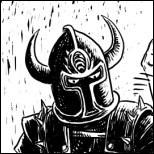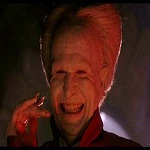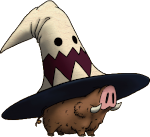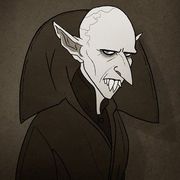|
Ruminating on it more, I think there are distinctly different problems with some of the broken classes. Like I can't tell you what the Fighter's 'thing' is. Since Superiority Dice are locked behind a feature path that's not really it. I guess you could say 'being the fighty-est' is their primary feature but I couldn't really tell you exactly what that means. They don't really do the most damage per AC (Paladins can almost certainly match them), they don't exclusively have the most HP. They have no core mechanic whatsoever. Even fighting styles are shared by other classes. Rogues do have their backstab bonus but it's tied entirely to Advantage. Aside from the damage bonus being underwhelming, it's a pretty lovely thing to design a class around. Combat Advantage with regards to Rogues was also kind of a lovely thing to build Rogues around in 4e, and for the same reason; everybody already wants it. It's making a good condition better. In 4e the Rogue had lots of ways to generate it, and many of their powers just poo poo out damage in massive numbers. I won't argue that's fantastic design (it's not) but it's better than 5e, where backstab as a 'feature' is almost certainly better rolled into a different class via multiclassing. "Having a lovely thing" versus "not having a thing at all" are different problems. It would probably be easier to improve the Rogue or the Barbarian because of this than it would be to fix the Fighter, since at least you have the basic concept of a mechanical skeleton to hang things on.
|
|
|
|

|
| # ? May 14, 2024 23:04 |
|
Can't 5E Rogues deal sneak attack just when they have an ally within 5' of the enemy?
|
|
|
|
Sage Genesis posted:I've played D&D for decades now and I have no idea what this is supposed to mean. THAC0 (To Hit Armor Class 0) from AD&D is superior to BAB (Base Attack Bonus) from d20 because you never have to add a bunch of small modifiers to THAC0. Example: 35 separate +1s to your attack bonus. The "optional star alignment" bit was a joke about the glut of optional content used in 3.P games to make the Fighter (and similarly lovely martial classes) viable. It's also a joke about how common these modifiers were circumstantial. Highly circumstantial. Did I suck all the fun out of the joke, yet?
|
|
|
|
Mendrian posted:Like I can't tell you what the Fighter's 'thing' is. Since Superiority Dice are locked behind a feature path that's not really it. I guess you could say 'being the fighty-est' is their primary feature but I couldn't really tell you exactly what that means. They don't really do the most damage per AC (Paladins can almost certainly match them), they don't exclusively have the most HP. They have no core mechanic whatsoever. Even fighting styles are shared by other classes. I had an interesting exchange the other day on another forum about how 4e had a problem with becoming needlessly restrictive. "What if I want to play a Fighter that uses a bow?", and the hell of it was that that person was sort of right - you really couldn't play a Fighter that uses a bow. If you want to play a Ranged + Damage-dealing + non-spellcasting character, that would point you towards the Ranger, which brings us back to the problem that before 4e, the Fighter didn't really have a thing that it was particularly good at, or even a theme that shaped how the Fighter did it beyond "does not use magic" 4e made Fighters explicitly about tanking and defending frailer partymates, but now we're back at 5e with Sentinel being a feat and the Fighter is just "guy who auto-attacks" again.
|
|
|
|
mastershakeman posted:Rogues don't really work in combat outside of a backstab. If you want them to be good you can do two simple things: backstab hits for x2 damage at levels 1-2, x3 at 3-6, x4 at 7-10, x5 11-15, x6 16-20 Thanks, grandpa. Vanguard Warden posted:I like the idea of accuracy fixing for martial classes, as right now the best martial characters are those with access to the Archery fighting style or the Precise Strike maneuver. Or both  Mendrian posted:Like I can't tell you what the Fighter's 'thing' is. Since Superiority Dice are locked behind a feature path that's not really it. I guess you could say 'being the fighty-est' is their primary feature but I couldn't really tell you exactly what that means. They don't really do the most damage per AC (Paladins can almost certainly match them), they don't exclusively have the most HP. They have no core mechanic whatsoever. Even fighting styles are shared by other classes. They get MORE extra attacks.
|
|
|
|
gradenko_2000 posted:I had an interesting exchange the other day on another forum about how 4e had a problem with becoming needlessly restrictive. "What if I want to play a Fighter that uses a bow?", and the hell of it was that that person was sort of right - you really couldn't play a Fighter that uses a bow. Why did they want to play "a fighter that uses a bow"? The fighter is a defender role (there was no ranged defender, which makes a sort of sense), if they didn't want to play that role why are they trying to be a fighter? Just reskin a ranger as a royal archer. People's fear of reskinning gets to me sometimes.
|
|
|
|
Keshik posted:Everyone has been posting pretty much nonstop about how 5e is not fun if you aren't a spellcaster. If you don't mind me hocking my own wares... https://docs.google.com/document/d/1_FqMPP17Ild_B_JCzY0ccjCL8qre_kvxE2sLCnUxGZU/edit?usp=sharing I've playtested these insofar as the Barbarian, Fighter, Paladin and Rogue changes. I have not gotten a chance to try the Monk or Ranger changes yet.
|
|
|
|
What it seems to come down to is people want to play a Ranger, Rogue, Barb, Paladin, etc to be better than a Fighter. But in that mindset, 'better' means better in combat, not all around. That's led to this really messed up development where fighters aren't good but also all the other martial classes end up being hampered as well. The way to actually houserule it: 0) for the 80th time, allow movement through initiative phases. Wow, tanking and positioning can actually occur without needing abilities, just players paying attention! 0a) Make it explicit that if someone/something is out of combat, it can be killed outright with an attack roll from bladed weapon. Hold person on someone or tie them up, can simply slit their throat. This leads to rogue things. 0b) Let classes level at different rates. Rogues fastest, then fighters, barbs, then rangers then paladins. The discrepancy in any power between classes can just be adjusted by having them be lower level. 1) Make Fighter the Best at Fighting. Most damage, most defense, most saves, most everything , both ranged and melee. Absolutely dominant forces on the battlefield, still powering through enemies after the rest of the party's been knocked out. 2) Make Ranger a fighter that trades fighting abilities for abilities like tracking, sneaking through nature, and a few nature themed abilities that are great for out of combat use and are unique to them. Rangers are basically fighter/rogues. 3) Make Barb a fighter that trades defense for offense through rage, but in short bursts. This may be 'better' in some campaigns and worse in others depending how the DM paces encounters. That's fine. 4) Make Paladins a fighter who trades martial weapon damage/attack bonus for divine abilities. Shouldn't be too hard to balance although it will be, after all barbs are just fighter/priests. 5) Make Rogues much worse at fighting in combat, but vastly better out of combat. Backstabs hitting for big multipliers by level, and same with instakills outside of combat. Make it so you need a good 4+ levels to really get a high chance of instakill (so like 25% chance to level 4, then 50, then 75, but by level 10 you're at 90%). Thieves guilds should be feared because they can simply sneak in and execute someone. 6) Monks. Dunno, a cross of Paladins and rogues. I've never really seen monks with mechanics that fit in well to the rest of the classes.
|
|
|
|
gradenko_2000 posted:I had an interesting exchange the other day on another forum about how 4e had a problem with becoming needlessly restrictive. "What if I want to play a Fighter that uses a bow?", and the hell of it was that that person was sort of right - you really couldn't play a Fighter that uses a bow. Well you sort of can, if you make a Slayer-type Fighter. But that's from Essentials, not the core PHB, so not everybody knows about that. That said, this argument misses the point of how classes are built in 4e. The "Fighter" is not a generic warrior but a rather specific archetype of its own. To make an archery Fighter is like making a non-magical Wizard: it just doesn't work that way. If you want to make an archer there's several good ways to do it and you only run into problems if you absolutely, desperately must have the word "Fighter" written on your character sheet. (Again, barring the Slayer.) You may call this "needlessly restrictive" but we've long since passed the era where D&D classes were broad, vague archetypes. The "Wizard" is no longer the unique arcane Magic-User class of old. Now it's just one of many arcane guys, along with the Sorcerer, Warlock, Bard, and in 5e also some flavors of Fighter, Rogue, and Monk. D&D is no longer the game of three or four broad classes. It has become the game of several narrow, specific classes. Except for Fighters because for some reason those guys must remain vague and watered down so they can be equally weak at everything that involves weapons (and now also magic).
|
|
|
|
Sage Genesis posted:Except for Fighters because for some reason those guys must remain vague and watered down so they can be equally weak at everything that involves weapons (and now also magic). Don't forget that for any debate about power levels, class scaling, and the capabilities of martials/non-magic users, EVERYONE who is not a caster must be compared to the Fighter even if you have established prior that the Fighter is hands down the worst and should not be a point of reference for game design. Thanks Pathfinder/3e.
|
|
|
|
Mendrian posted:Like I can't tell you what the Fighter's 'thing' is. To me, the best source to mine for the kernels of mechanics is the fictional world(s) the rules system is supposed to represent. Good class based systems ensure classes match-up to the fictional archetypes they are supposed to represent and I think that's where D&D, in general, has the most issues. In 2nd ed. they provided a list of historical, mythical, and fictional characters you'd use a D&D fighter to represent: Hercules, Perseus, Hiawatha, Beowulf, Siegfried, Cuchulain, Little John, Tristan, Sinbad, El Cid, Hannibal, Alexander the Great, Charlemagne, Spartacus, Richard the Lionheart, and Belisarius. A class that could model all these guys would need to be supernaturally strong and tough, count on divine guidance and support, and not only be a leader of men, but a great leader of men able to reshape the course of history. That's on top of the obvious highly skilled at fighting bit. Spit balling here, (in a mostly edition neutral way) but a Fighter's core features should be something like: Combat Prowess: In addition to being the best all-around warriors, fighters inspire others to fight at their best.
Heroics: Fighters are larger than life figures capable of incredible feats of strength, stamina, and skill.
|
|
|
|
Non-rhetorical: aside from tradition, why does D&D even need a class called 'Fighter'. Maybe the naming isn't so important, but I think it's interesting that people often bring up leaders of men when discussing Fighters, while nothing in the mechanics of 3E+ would suggest this. In either case, every class in D&D is supposed to fight - why not call the Fighter the Captain or Marshal or something instead? I know the naming isn't hugely important, but I feel people often frame their arguments through it. In addition, as was brought up before, a lot of people discuss classes like Barbarian/Paladin/Ranger/Rogue as [Fighter + some stuff] or [Fighter, trading x for y].
|
|
|
|
Tradition (that doesn't exist) and buttock-shattering fear of "shouting arms back on".
|
|
|
|
GrizzlyCow posted:THAC0 (To Hit Armor Class 0) from AD&D is superior to BAB (Base Attack Bonus) from d20 because you never have to add a bunch of small modifiers to THAC0. Example: 35 separate +1s to your attack bonus. Tons of little modifiers to stats has nothing to do with THAC0 or BAB. You could design a system with THAC0 that has tons of modifiers and a system with BAB that doesn't.
|
|
|
|
IT BEGINS posted:Non-rhetorical: aside from tradition, why does D&D even need a class called 'Fighter'. Maybe the naming isn't so important, but I think it's interesting that people often bring up leaders of men when discussing Fighters, while nothing in the mechanics of 3E+ would suggest this. In either case, every class in D&D is supposed to fight - why not call the Fighter the Captain or Marshal or something instead? I know the naming isn't hugely important, but I feel people often frame their arguments through it. In addition, as was brought up before, a lot of people discuss classes like Barbarian/Paladin/Ranger/Rogue as [Fighter + some stuff] or [Fighter, trading x for y]. We had a Marshal in 3.5. It was an inferior Bard with no magic.
|
|
|
|
IT BEGINS posted:Non-rhetorical: aside from tradition, why does D&D even need a class called 'Fighter'. Maybe the naming isn't so important, but I think it's interesting that people often bring up leaders of men when discussing Fighters, while nothing in the mechanics of 3E+ would suggest this. In either case, every class in D&D is supposed to fight - why not call the Fighter the Captain or Marshal or something instead? I know the naming isn't hugely important, but I feel people often frame their arguments through it. In addition, as was brought up before, a lot of people discuss classes like Barbarian/Paladin/Ranger/Rogue as [Fighter + some stuff] or [Fighter, trading x for y]. This goes back to the Warrior/Fighter naming issue. At least in 2e, Warrior was the term for all types of these guys (fighter, paladin, ranger, etc). Yet they named the splatbook the Complete Fighter's Handbook instead of Complete Warrior's for some reason. Then there was a Complete Ranger/Paladin as well so who the heck knows! Basically 'warrior' should be the term for any/all martial fightingman guys.
|
|
|
|
wallawallawingwang posted:Whenever a fighter rolls more than, say, a 6 on a damage die, they should get a free disarm/trip/shove/whatever, on their target. I was thinking of something like this, by making something similar to battlemaster maneuvers available to martial classes generally. Like you have a number of resource points (2 + 1/2 your martial class level, maybe), and you regain d4 + your con. bonus each time you roll initiative (upgrading to d6 and d8 in later levels). Have some key off dex, some off strength, and some apply specifically to weapon types. e.g.
You would differentiate the fighter by making him strictly better at this stuff (say, he gets more maneuver points, he regains more with each initiative roll, fighter levels count for double when calculating extra damage, etc.) and with additional out of combat stuff like you suggest. I think another merit would be you could tweak it to make melee and strength-based characters more attractive, to compensate in some way for dex being an overall more useful attribute.
|
|
|
|
IT BEGINS posted:Non-rhetorical: aside from tradition, why does D&D even need a class called 'Fighter'. Maybe the naming isn't so important, but I think it's interesting that people often bring up leaders of men when discussing Fighters, while nothing in the mechanics of 3E+ would suggest this. In either case, every class in D&D is supposed to fight - why not call the Fighter the Captain or Marshal or something instead? I know the naming isn't hugely important, but I feel people often frame their arguments through it. In addition, as was brought up before, a lot of people discuss classes like Barbarian/Paladin/Ranger/Rogue as [Fighter + some stuff] or [Fighter, trading x for y]. Fighters as leaders of men come from the hoary depths of pre-3.X. Back when characters had name levels and followers and what not fighters got to roll on one of the better follower tables. Really, D&D needs to bite the bullet and breakup classes like Wizard into a dozen or so classes, or sub-classes or whatever, to represent all the different schools of magic and different types of fictional spell casters. Which is the only way "guy who has lots of skills and fights in light armor with two swords" and "guy who has lots of skills but fights in light armor with a knife" can ever hope to be meaningfully different classes. OR it needs to roll Barbarian/Paladin/Ranger/Thief/Warlord all back into a single class. EG: I play a fighter and right now he's practiced with the barbaric fighting style since our boat crashed on Dinosaur Island, but when I get back to town he's going to go back to his usual swashbuckler style. If you go that route D&D really only needs 3 classes: is a heroic human, is a magic human, is a non-human and just let those classes be broad enough to fit nearly anything. wallawallawingwang fucked around with this message at 02:32 on Jun 24, 2015 |
|
|
|
wallawallawingwang posted:Really, D&D needs to bite the bullet and breakup classes like Wizard into a dozen or so classes, or sub-classes or whatever, to represent all the different schools of magic and different types of fictional spell casters.
|
|
|
|
In the "Princes of the Apocalypse" PbP, we're using these houserules for a "simple but effective" Fighter tl;dr It seems alright except it needs some way to close distance and/or be good at range. This is more of a system-wide problem than one specific to Fighters. Ryuujin posted:they straight up get a feat every time they pick up a fighter Archetype feature. So 3rd, 7th, 10th, 15th, and 18th Fighter levels. This will grant a straight fighter more feats in the long run. Ryuujin posted:The Feat they get should reflect the Archetype, or possibly their Background or Fighting Style. edit: we also added something in there where their damage dice goes up, currently 1d8->3d4 @ level 5ish P.d0t fucked around with this message at 08:29 on Jun 24, 2015 |
|
|
|
wallawallawingwang posted:Fighters as leaders of men come from the hoary depths of pre-3.X. Back when characters had name levels and followers and what not fighters got to roll on one of the better follower tables. Just limiting what spells can do would go a long way, I think. If I ever run 5e for some reason, I'll probably go through the spell list with a fine-toothed comb and just... remove a bunch of spells, the ones that step on what martials can do the most. I am probably not going to run 5e, though. D&D probably won't ever limit what the Wizard is capable of again, if I had to guess. The audience they're apparently targeting thinks that martials who can do cinematic or superhuman feats breaks their verisimilitude, but also, saying that there are things magic can't do also breaks their verisimilitude. For them, the Fighter should be Generic Soldier Guy. The Wizard should be Gandalf, but Flashier.
|
|
|
|
Harrow posted:For them, the Fighter should be Generic Soldier Guy.
|
|
|
|
My Lovely Horse posted:And I think that's the point of why there is a Fighter class in the first place: a whole lot of people see the game rules as description of the world, both in the sense of physics and social structure, with a good bit of real-world historical accuracy thrown in the mix, and of course under that premise there needs to be an element that accurately depicts the common foot soldier. Maybe that's the solution. Make a baseline, featureless Fighter class that is deliberately and obviously sub par and then have all the other martials be "As Fighter of the same level with the following additional benefits:". Grogs get their generic, "newbie friendly" fighter class, all other martials actually get to perform.
|
|
|
|
What was the design philosophy behind 3e? It seems like that was really where things broke. I don't know a lot about the shift from 2->3. What seems even weirder is the popular books/settings primarily featured martial classes as the main characters, so I'd think that WOTC would've wanted to keep those at the forefront.
|
|
|
|
Splicer posted:But even 3e had the Warrior NPC class for that. Better still, make a baseline, featureless Fighter class that is deliberately and obviously sub par and then have all the PC martials be etc etc. The "newbie friendly" version can be the simplest one of those. The baseline, featureless Fighters can exist as bad guys, unimportant NPCs, and class-feature followers for PC martials.
|
|
|
|
mastershakeman posted:What was the design philosophy behind 3e? It seems like that was really where things broke. I don't know a lot about the shift from 2->3. What seems even weirder is the popular books/settings primarily featured martial classes as the main characters, so I'd think that WOTC would've wanted to keep those at the forefront.
|
|
|
|
AlphaDog posted:Better still, make a baseline, featureless Fighter class that is deliberately and obviously sub par and then have all the PC martials be etc etc. The "newbie friendly" version can be the simplest one of those. That's a good start, especially if we call the baseline, featureless one "Fighter" to keep the grogs happy that the Fighter still sucks. The problem is that it won't really accomplish much, narrative balance-wise, unless we also scale back what magic is capable of doing. Looking at 5e as it stands right now, you could merge the abilities of all the Fighter subclasses and even speed up the progression on their multiple attacks per round and they'd still get chumped by full casters. Either a caster can take out a whole encounter with a couple of save-or-suck spells, or they can buff themselves up and out-Fighter the Fighter. (This won't happen, however, because verisimilitude demands that anything we call "magic" be limitless in its scope! Otherwise it's not really magic, duh.) Anyway, we're essentially mimicking the design process behind 4e right now, which should probably tell us something. I always did wish that 4e had diversified "resource" mechanics sooner. While the psionic classes were a little wonky in their balance--Psions, especially, had anemic Dailies but awesome powered-up At-Wills--I loved the fact that they had a slightly different resource mechanic than other power sources. It would be cool to have a version of 4e where not every power source follows the At-Will/Encounter/Daily resource scheme, or each power source has some twist on that. It would've been trickier to balance, for sure, but might've been cool.
|
|
|
|
Harrow posted:I always did wish that 4e had diversified "resource" mechanics sooner. While the psionic classes were a little wonky in their balance--Psions, especially, had anemic Dailies but awesome powered-up At-Wills--I loved the fact that they had a slightly different resource mechanic than other power sources. It would be cool to have a version of 4e where not every power source follows the At-Will/Encounter/Daily resource scheme, or each power source has some twist on that. It would've been trickier to balance, for sure, but might've been cool. Well divine classes had their domains and channel divinity. Martial classes get the style feats. Arcane just generally gets more diversity. I don't actually know anything about Primal classes. Never really played one. Shadow doesn't really count because it has all of three classes and they all work very differently.
|
|
|
|
mastershakeman posted:What was the design philosophy behind 3e? It seems like that was really where things broke. I don't know a lot about the shift from 2->3. What seems even weirder is the popular books/settings primarily featured martial classes as the main characters, so I'd think that WOTC would've wanted to keep those at the forefront. As far as I can remember from reading Dragon Magazine 15 years ago and as far as I can deduce from the rules they created, the designers of 3.0 had the following goals: 1. Replace AD&D's ad-hoc, kludged together subsystems with a unified mechanic: d20+modifiers v. DC. 2. Make life easier for the DM by standardizing/rationalizing the rules: challenge ratings and wealth by level are the clearest examples, but generally I think most of the weird, nitpicky rules in Third Edition are there so that the DM doesn't have to spend time houseruling, or making judgment calls on the fly. 3. Allow for more character customization and remove legacy restrictions on PC creation (Options, not Restrictions!) 4. Push the game "Back to the Dungeon!" and away from railroady, 90's-style "story" based adventures.
|
|
|
|
Harrow posted:That's a good start, especially if we call the baseline, featureless one "Fighter" to keep the grogs happy that the Fighter still sucks. The problem is that it won't really accomplish much, narrative balance-wise, unless we also scale back what magic is capable of doing. Looking at 5e as it stands right now, you could merge the abilities of all the Fighter subclasses and even speed up the progression on their multiple attacks per round and they'd still get chumped by full casters. Either a caster can take out a whole encounter with a couple of save-or-suck spells, or they can buff themselves up and out-Fighter the Fighter. To tie into the discussion about the 2e - 3e transition, the way you make martial characters as good as wizards without powers is to give them manpower like they got back in 2ed, but with actual rules supporting it. One of the big reasons the 3e fighter sucks compared to the wizard is that while the wizard was de-sucked from 2e - 3e (which was necessary), the fighter's high-level "power" (ie, "has a literal army") was simply excised from the game. Give fighters back their followers. It doesn't have to be "you get 300 soldiers, 30 elite bodyguards, and 2 mid level lieutenants" like 2e, it just needs to be sufficient competent manpower that the fighter can get effects like those that the wizard can get. Tenser's Floating Disc vs "Grab a sack of coins each boys, we're leaving." Alarm vs "Sergeant Timms, set watch." Evard's Black Tentacles vs "Guards! Seize Him!" Wall Of Iron vs "Form a shield wall! Hold the line!" Rock To Mud vs "Bring up the battering ram."
|
|
|
mastershakeman posted:What it seems to come down to is people want to play a Ranger, Rogue, Barb, Paladin, etc to be better than a Fighter. But in that mindset, 'better' means better in combat, not all around. That's led to this really messed up development where fighters aren't good but also all the other martial classes end up being hampered as well. For instance, varied XP per level doesn't mesh at all with the way multiclassing works in 5e. Which is also a mess, frankly, but it doesn't need to get any messier. Plus it also mandates strict XP tracking, which I I'm not a fan of. That's strictly a personal preference thing though. Also, saying "make the fighter the best at fighting" and "make the rogue suck in combat and great out of it" makes me twitch. We should be moving towards better parity in effectiveness in the "3 Pillars", not away from it. Fighters should be able to size people up in social situations or get a crowd on their side through boasting about their deeds. And given the mechanical weight, the usual consequences of failure, and average duration of combat in D&D, everyone should be good at it.
|
|
|
|
|
ImpactVector posted:From that list, it looks like you just want to play 2e. Nothing wrong with that, but a lot of those suggestions don't fit with any newer D&Ds. That's a real good point about rogues. It's honestly hard to balance them by trading damage for durability but not making them superior to a fighter in light armor. There probably just shouldn't even be a rogue class when it comes down to it.
|
|
|
mastershakeman posted:That's a real good point about rogues. It's honestly hard to balance them by trading damage for durability but not making them superior to a fighter in light armor. There probably just shouldn't even be a rogue class when it comes down to it. I think it would be more interesting if combat as rogue was rethought to maybe be about class abilities that enable creative use of skills to defeat enemies in combat, instead of just being a fragile fighter with circumstantially high damage output. They could be more along "the guy who's actually not that good at fighting, but manages to defeat, or make the enemy defeat themselves, through luck, guile, quick wit or a combination thereof". It seems like it would be closer to the archetypical portrayal of rogues in fiction anyway. That way, fighters could perhaps get to care primarily about attack rolls and AC in combat and wizards about saving throws and concentration checks, while rogues get the skill checks as their own thing in combat.
|
|
|
|
|
Slashrat posted:They could be more along "the guy who's actually not that good at fighting, but manages to defeat, or make the enemy defeat themselves, through luck, guile, quick wit or a combination thereof". It seems like it would be closer to the archetypical portrayal of rogues in fiction anyway.  > >
|
|
|
|
Splicer posted:But even 3e had the Warrior NPC class for that. "All Fighter Variants are too Anime/Wuxia/WoW, break my verisimilitude, and will not be allowed at my table." Doesn't fuckin'' matter what or how you try to fix or improve martial characters, the moment they begin to gain narrative control on the same level as casters, they're broken, and must be removed in the viewpoint of the target audience for 5e. See: All of 4e, Book of Nine Swords, Dungeonscape goatface posted:Why did they want to play "a fighter that uses a bow"? The fighter is a defender role (there was no ranged defender, which makes a sort of sense), if they didn't want to play that role why are they trying to be a fighter? Just reskin a ranger as a royal archer. Reskin all day every day. One of the best campaigns I've ever played in had a player who was using a reskinned Bugbear Barbarian who was dual-wielding Longswords in order to play the party's Owlbear. Another was playing a warforged warlord who reskinned his spear into an Inspector-Gadget style Extendo-Punch. A third was playing a Chaos Magic Sorcerer who channeled his powers through a rift in the Elemental Chaos that had opened inside his brain, reskinning the halfling and Chaos Magic luck feats and powers into a literal personal denial of reality. He tended to ride the Owlbear around, firing energy from its back like some nightmarish Hooting, Feathered Main Battle Tank. A fourth was a Dwarven Hobo who reskinned his Craghammer as the Iron Pot he cooked his Hobo-Stew in. I fuckin' MISS that campaign. Bassetking fucked around with this message at 19:18 on Jun 24, 2015 |
|
|
|
Make rogues the only ones who get skills period. Wizards can do stuff with spells and fighters can employ their raw ability scores, but no one's as diverse and specialized as a rogue. Maybe give each skill a hardcoded application.
|
|
|
|
My Lovely Horse posted:Make rogues the only ones who get skills period. Wizards can do stuff with spells and fighters can employ their raw ability scores, but no one's as diverse and specialized as a rogue. Maybe give each skill a hardcoded application. That just screws fighters unless you're also looking to have some wizards only capable of in combat spells and other magic classes only capable of out. Merging fighter and rogue into guy who does everything without magic, via weapons and skills, makes the most sense.
|
|
|
|
Harrow posted:Just limiting what spells can do would go a long way, I think. If I ever run 5e for some reason, I'll probably go through the spell list with a fine-toothed comb and just... remove a bunch of spells, the ones that step on what martials can do the most. That's a fair approach. It's easy to add lots of damage to the martial, or even monster-disabling-save-or-suck effects, but it's difficult to get them to catch up to a caster's out-of-combat utility, or specifically their ability to control the pace of the campaign via things like teleportation, summoning and the likes. Unfortunately, it's also a huge task to comb through the spell list and throw out everything that isn't direct-damage, crowd control, status effect, or small-enough-utility-to-be-retained. mastershakeman posted:What was the design philosophy behind 3e? It seems like that was really where things broke. I don't know a lot about the shift from 2->3. What seems even weirder is the popular books/settings primarily featured martial classes as the main characters, so I'd think that WOTC would've wanted to keep those at the forefront. The Unified Mechanic played a part in the nerfing of the Fighter because the saving throw progression wasn't nearly as good as it used to be in AD&D. Not only were the Wizards so much more successful at shutting down monsters, the Fighters themselves were more vulnerable to getting hit by spells that the DM decided to use against them. Iterative attacks were supposed to be a sort of replacement for AD&D's attacks-per-round progression. You didn't want to give the Fighter a second attack right away because that would a flat doubling of their damage, so in AD&D you made it 3-attacks-per-2-rounds, but that was also clumsy because you had to count rounds or check if the round was odd or even or something. Iterative attacks were supposed to be more intuitive: it's a second attack, straight-up, but it hits less often - the higher miss chance should result to a similar effect as only letting the Fighter attack every other round! Except the problem with that approach was that iterative attacks were full-round actions, so the Fighter now has mobility issues. Feats were another big deal with the 3rd Edition. The idea was that they were going to emulate things like Smash, or Set Spear, or any of the other Weapon Specialization abilities from the RC so that the Fighter would have something to do besides making basic attacks all the time. Except it didn't really work because the design was never focused enough: some feats denied actions that you used to be able to do when it was still unspecified, some feats were small incremental bonuses, and lots of feats were entirely passive effects that could never really compare to a "spell" And then finally there's what AlphaDog mentioned about the Fighter's Lordship and posse being taken away from them with no compensation, along with the Wizard having much easier access to spells. mastershakeman posted:That's a real good point about rogues. It's honestly hard to balance them by trading damage for durability but not making them superior to a fighter in light armor. There probably just shouldn't even be a rogue class when it comes down to it. To bring this back around to how the thread is essentially recreating the design process that lead to 4th Edition, the Fighter:Rogue comparison is difficult because we really don't have any firm concept of what the Fighter should be. I mean, if we agree that a Rogue shouldn't suck at combat just because it can do out-of-combat things that the Fighter cannot (which is bad design), then that points us to the Rogue and the Fighter should be able to contribute equally well during combat. But if the Fighter is "dude who swords people in the face really well", what is the Rogue compared to a damage-dealer that's also wearing plate? 4E rationalized this by actually assigning the Fighter a role: he's wearing the plate, he defends everybody else. That way, you've got "dude who swords people in the face really well" represented by the Rogue, and then "dude who stops the bad dudes from swording others in the face" represented by the Fighter. Because if the alternative is that they are distinct due to theme, then one of them still has to go: Barbarian is savage face-swording, Paladin is holy face-swording, Rogue is stealthy face-swording, and Fighter is ... what? It's a rather intractable problem if you're not willing to sacrifice any sacred cows.
|
|
|
mastershakeman posted:That just screws fighters unless you're also looking to have some wizards only capable of in combat spells and other magic classes only capable of out. Merging fighter and rogue into guy who does everything without magic, via weapons and skills, makes the most sense. But for fighters, you could let them use their martial superiority dice to add to so many checks per day/rest/whatever, with no restrictions on what kind of check they can add them to. Dunno if that's balanced, just spitballing.
|
|
|
|
|

|
| # ? May 14, 2024 23:04 |
|
That was about what I was thinking (and trust me, it wasn't what you'd call a well-matured idea). Anyone can attempt anything using ability checks, but rogues get specific skills that mean a) they can do specific things with them and b) they will be slightly better at an ability check if it falls in the range of a skill they have. (Although if you're going that route, you could just as well also copy the same system over to casters and replace the skill names with magic schools or divine domains.) Ideally skills and spells alike would be things that help in combat without outright invalidating the idea of combat. And fighters could still be Best At Actual Fighting. What also works is what 13th Age does - anyone can attempt to do anything, but some classes can do stunts and succeed automatically. My Lovely Horse fucked around with this message at 20:11 on Jun 24, 2015 |
|
|


































